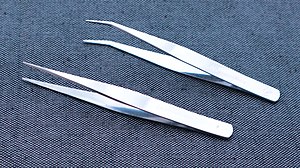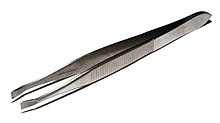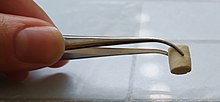Tweezers
This articleneeds additional citations forverification.(June 2008) |


Tweezersare smallhand toolsused for grasping objects too small to be easily handled with the humanfingers.Tweezers are thumb-drivenforcepsmost likely derived fromtongsused to grab or hold hot objects since the dawn ofrecorded history.In a scientific or medical context, they are normally referred to as just "forceps", a name that is used together with other graspingsurgical instrumentsthat resemblepliers,pincersandscissors-likeclamps.
Tweezers make use of two third-classleversconnected at one fixed end (thefulcrumpoint of each lever), with the pincers at the others. When used, they are commonly held with one hand in a pen grip between thethumbandindex finger(sometimes also themiddle finger), with the top end resting on the firstdorsal interosseous muscleat the webspace between the thumb and index finger. Spring tension holds the grasping ends apart until finger pressure is applied. This provides an extendedpinchand allows the user to easily grasp, manipulate and quickly release small or delicate objects with readily variable pressure.
People commonly use tweezers for such tasks asplucking hairfrom the face or eyebrows, often using the term eyebrow tweezers. Other common uses for tweezers are as a tool to manipulate small objects, including for example small, particularlysurface-mount,electronic parts,and small mechanical parts formodelsand precision mechanisms.Stamp collectorsuse tweezers (stamp tongs) to handlepostage stampswhich, while large enough to pick up by hand, could be damaged by handling; the jaws of stamp tongs are smooth. Another example of a specialized use is picking out the flakes of gold ingold panning.Tweezers are also used in kitchens forfood presentation[1]to remove bones from fillets of fish in a process known as pin boning, and are as tongs used to serve pieces of cake to restaurant patrons.
History
[edit]

Tweezers are known to have been used inpredynastic Egypt.There are drawings of Egyptiancraftsmenholding hot pots overovenswith a double-bow shaped tool. Asiatic tweezers, consisting of two strips of metal brazed together, were commonly used in Mesopotamia and India from about 3000 BC, perhaps for purposes such as catching lice.[2]During theBronze Age,tweezers were manufactured inKerma.[3]
The word tweezer comes from etwee which describes a small case that people would use to carry small objects (such as toothpicks) with them. Etwee takes its origin from Frenchétui"small case" from theOld Frenchverbestuier,"to hold or keep safe." Over time, the object now known as "tweezers" took on this name because the tool was commonly found in these tiny carrying cases. Eventually, the word "tweeze" was accepted as a verb in the English language.
There is evidence of Roman shipbuilders pulling nails out of construction with plier-type pincers.
Types
[edit]

Tweezers come in a variety of tip shapes and sizes.[4]Blunt tip tweezers have a rounded end which can be used when a pointed object may get entangled, when manipulatingcotton swabs,for example. Flat tip tweezers, pictured at right, have an angled tip which may be used for removingsplinters.Some tweezers have a long needle-like tip which may be useful for reaching into small crevices. Triangular tip tweezers have larger, wider tips useful for gripping larger objects. Tweezers with curved tips also exist, sometimes called bentforceps.Microtweezers have an extremely small, pointed tip used for manipulating tiny electronic components and the like.
There are two common forms of construction for tweezers: two fused, angled pieces of metal, or one piece of metal bent in half. The bent tweezer is cheaper to manufacture, but gives weaker grip. The fused tweezer is more expensive, but allows for a stronger grip. The width between the tips of the tweezers when no force is applied also affects how powerful the grip is.

Cross-locking tweezers(aka reverse-action tweezers or self-closing tweezers) work in the opposite way to normal tweezers. Cross-locking tweezers open when squeezed and close when released, gripping the item without any exertion of the user's fingers.
Usage of traditional tweezers
[edit]

Applications:
- typesetting
- dealing with stamps (seePhilately)
- dealing with smaller coins (seeNumismatics), to protect the coins these are wrapped at the tips with plastic
- electronics
- soldering
- cosmetics
- hair removal (eyebrow tweezers)
- nail art (application of gems, stickers etc to fingernails or toenails as part of a manicure)
- semiconductor technology in the form of wafer tweezers
- medicine (Forceps and Tissue Forceps)
- household
- jewelry making
- textile industry as iron nubs[clarification needed]
- science, laboratory
- aquascaping
- watchmaking
Other kinds of tweezers
[edit]The original tweezers for mechanical gripping have given rise to a number of tools with similar action or purpose but not dependent upon mechanical pressure, including
- Optical tweezersuse light to manipulate microscopic objects as small as a singleatom.The momentum transfer from a focused laser beam is able to trap small particles.[5]In thebiological sciences,these instruments have been used to apply forces in the pico Newton range and to measure displacements in the nm range of objects ranging in size from 10 nm to over 100 mm.[citation needed]
- Magnetic tweezersuse magnetic forces to manipulate single molecules (such as DNA) via paramagnetic interactions. In practice it is an array of magnetic traps designed for manipulating individual biomolecules and measuring the ultra-small forces that affect their behavior.
- Electric tweezersdeliver an electrical signal through the tip, intended fordepilationby damaging hair roots to prevent new hair from growing from the same root.
- Electrostatic tweezersuse electrostatic voltage toinducethe redistribution of charges in targeted objects, therefore generating Coulomb attraction force between tweezers and manipulated objects. Electrostatic tweezers work in a trapping mode or guiding mode.[6]
- Vacuum tweezersuse differences in atmospheric pressure to grasp items from 100 micrometres in size up to parts weighing several pounds. Special vacuum tweezer tips are manufactured to handle a wide variety of items such as surface-mount electronics, optics, biological material, stamps and coins. They may be used to handle parts that are so small that conventional mechanical tweezers may cause parts to be damaged or dropped and lost.
- Acoustic tweezersuse sound to manipulate particles or cells in the fluid. An elegant Gor'kov potential theory is used most for small sizes compared with the incident wavelength.
- Molecular tweezersare noncyclichost moleculesthat have two arms capable of binding guests molecules throughnon-covalentbonding.
- Hot, or soldering, tweezers combine the squeezing action of mechanical tweezers with heating, to grip smallsurface-mountelectronic devices while simultaneously heating them, forsolderingor desoldering.
- Tweezer probes are a pair of electricaltest probesfixed to a tweezer mechanism to measure voltages or otherelectronic circuitparameters between closely spaced pins.
- Tweezers integrated with an electronic measuring device for evaluation of electrical parameters of small-size electronic components.[7]
- Carbon nano-tweezers have been fabricated by deposition of MWNT bundles on isolated electrodes deposited on tempered glass micropipettes. Those nanotube bundles can be mechanically manipulated by electricity and can be used to manipulate and transfer micro- and nano-structures. The nanotube bundles used for tweezers are about 50 nm in diameter and 2 μm in lengths. Under electric bias, two close sets of bundles are attracted and can be used as nanoscale tweezers.
Other uses of the same principle are named tweezers; although such terms are not necessarily widely used their meaning is clear to people in the relevant field. E.g., Raman tweezers, which combineRaman spectroscopywith optical tweezers.[8]
See also
[edit]- Eyelash curler
- Instruments used in general surgery
- Optical tweezers,which use highly focused small lasers and a lens to stabilize atom or cell-sized small objects; the chief inventor won half the 2018Nobel Prize in Physics
References
[edit]- ^Tocantweezer (December 2015)."Christmas Bakery – Santa Claus Cake Made With Gerald Tweezers".Tocan-Tweezer.org.Archived fromthe originalon 2015-12-22.Sourceforge project. (CC-BY-SA)
- ^Childe V (1963).The Bronze Age.Archives of civilization. Vol. 3. Biblo & Tannen Publishers.ISBN978-0-8196-0123-0.
- ^Bianchi RS (2004).Daily Life of the Nubians.Greenwood Publishing Group. p. 81.ISBN978-0-313-32501-4.
- ^"Eyelash made in different sizes and shapes".qualitybeautystore.2 July 2019.
- ^Ashkin A, Dziedzic JM, Bjorkholm JE, Chu S (May 1986)."Observation of a single-beam gradient force optical trap for dielectric particles".Optics Letters.11(5): 288–290.Bibcode:1986OptL...11..288A.doi:10.1364/ol.11.000288.PMID19730608.
- ^Jin Y, Xu W, Zhang H, Li R, Sun J, Yang S, et al. (January 2022)."Electrostatic tweezer for droplet manipulation".Proceedings of the National Academy of Sciences of the United States of America.119(2).Bibcode:2022PNAS..11905459J.doi:10.1073/pnas.2105459119.PMC8764671.PMID34992136.
- ^"Multimeter/LCR Meter tweezers".advancedevices.Archived fromthe originalon July 19, 2013.RetrievedJanuary 17,2020.
- ^Hewett J (27 February 2002)."Raman tweezers probe living cells".optics.org.Archivedfrom the original on March 3, 2008.Retrieved2020-01-17.
